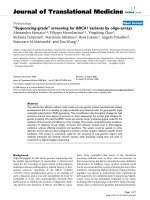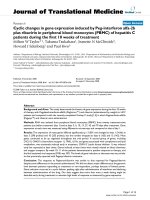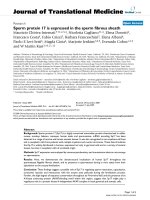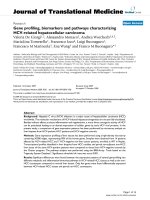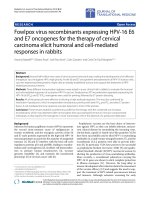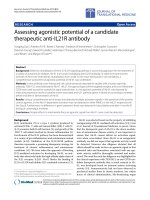Báo cáo hóa học: " Vaccinia virus replication is not affected by APOBEC3 family members" pptx
Bạn đang xem bản rút gọn của tài liệu. Xem và tải ngay bản đầy đủ của tài liệu tại đây (559.89 KB, 8 trang )
BioMed Central
Page 1 of 8
(page number not for citation purposes)
Virology Journal
Open Access
Research
Vaccinia virus replication is not affected by APOBEC3 family
members
Melanie Kremer, Yasemin Suezer, Yolanda Martinez-Fernandez,
Carsten Münk, Gerd Sutter and Barbara S Schnierle*
Address: Paul-Ehrlich-Institut, Paul-Ehrlich-Str. 51–59, 63225 Langen, Germany
Email: Melanie Kremer - ; Yasemin Suezer - ; Yolanda Martinez-Fernandez - ;
Carsten Münk - ; Gerd Sutter - ; Barbara S Schnierle* -
* Corresponding author
Abstract
Background: The APOBEC3G protein represents a novel innate defense mechanism against
retroviral infection. It facilitates the deamination of the cytosine residues in the single stranded
cDNA intermediate during early steps of retroviral infection. Most poxvirus genomes are relatively
A/T-rich, which may indicate APOBEC3G-induced mutational pressure. In addition, poxviruses
replicate exclusively in the cytoplasm where APOBEC3G is located. It was therefore tempting to
analyze whether vaccinia virus replication is affected by APOBEC3G.
Results: The replication of vaccinia virus, a prototype poxvirus, was not, however, inhibited in
APOBEC3G-expressing cells, nor did other members of the APOBEC3 family alter vaccinia virus
replication. HIV counteracts APOBEC3G by inducing its degradation. However, Western blot
analysis showed that the levels of APOBEC3G protein were not affected by vaccinia virus infection.
Conclusion: The data indicate that APOBEC3G is not a restriction factor for vaccinia virus
replication nor is vaccinia virus able to degrade APOBEC3G.
Background
During evolution, eukaryotic cells had to cope with a large
amount of pathogens. The interaction of host and patho-
gen required defense responses in the host, which resulted
in the development of the innate immune system. Due to
this high selection pressure, pathogens developed strate-
gies to escape or manipulate the host immune defense.
Poxviridae in particular, evolved several mechanisms for
immune evasion [1,2]. The best known members of this
family are variola and vaccinia virus. Variola virus is the
causative agent of smallpox, and although eradicated in
the early 70s, it still represents a serious threat as a possi-
ble agent for bioterrorism. Vaccinia virus (VACV) is the
prototype poxvirus and is frequently used as a vector for
vaccine development. The large double-stranded DNA
genome of poxviruses is 130 to 300 kb in size, and
although most genomes are completely sequenced, the
function of many genes necessary for viral infection, rep-
lication and immune evasion are not known [3].
APOBEC3G is a recently discovered defense mechanism
against retroviral infection [4]. The protein becomes
encapsidated into retroviral particles and is transported
into the infected cell, where it facilitates deamination of
cytosine residues in the single stranded cDNA intermedi-
ate during early steps of infection. APOBEC3G has been
Published: 19 October 2006
Virology Journal 2006, 3:86 doi:10.1186/1743-422X-3-86
Received: 30 August 2006
Accepted: 19 October 2006
This article is available from: />© 2006 Kremer et al; licensee BioMed Central Ltd.
This is an Open Access article distributed under the terms of the Creative Commons Attribution License ( />),
which permits unrestricted use, distribution, and reproduction in any medium, provided the original work is properly cited.
Virology Journal 2006, 3:86 />Page 2 of 8
(page number not for citation purposes)
shown to be an exclusive DNA mutator [5]. The replace-
ment of C with U in the DNA minus strand during reverse
transcription leads to G to A transitions in the plus strand.
APOBEC3G, therefore, triggers G to A hypermutations in
the newly synthesized viral DNA. The inhibition of viral
replication is due either to degradation of the cDNA by
the DNA repair machinery or to the lethality of the hyper-
mutations.
In addition to its anti-retroviral function [4,6],
APOBEC3G is also able to restrict hepadnaviruses [7], and
its gene family member APOBEC3A inhibits parvovirus
replication [8]. APOBEC3G is located in the cytoplasm of
the cell where it performs its function. VACV undergoes its
complete viral life cycle in the cytoplasm, and most pox-
virus genomes are relatively A/T-rich, which could be
caused by APOBEC3G-induced mutational pressure [9].
We were, therefore, interested to determine whether
APOBEC3G is also a restricting factor for this virus.
Results and Discussion
To assess the impact of APOBEC3G on the VACV life cycle,
we used HeLa-APOBEC3G cells which were stably trans-
fected with an APOBEC3GmycHis expression plasmid
encoding a Myc- and 6-His-tagged protein [10]. Intracel-
lular APOBEC3G expression was confirmed by flow
cytometry after staining the cells with a mouse anti-Myc
antibody. About 90% of the HeLa-APOBEC3G cells
expressed APOBEC3G (Figure 1A). HeLa-APOBEC3G
cells were infected with VACV of the strain Western
Reserve (VACV-WR) at an MOI of 0.05. This ensured con-
tinuous viral replication and viral spread throughout the
cell culture. Cells were harvested and viral titers were
determined 0, 24 and 48 h post infection on RK13 cells.
As shown in Figure 1B, there were no differences in viral
replication in HeLa-APOBEC3G cells compared to the
parental HeLa cells, which do not express APOBEC3G. Tit-
ers from VACV-infected HeLa-APOBEC3G cells were even
slightly higher at 48 h post infection. This indicates that
APOBEC3G has no negative effect on VACV replication.
To confirm the results obtained with HeLa cells, we also
investigated viral replication in APOBEC3G-expressing
293T cells. 293T cells were transiently transfected with the
APOBEC3GmycHis expression plasmid. The transfection
efficiency was determined by intracellular APOBEC3G
staining with a mouse anti-Myc antibody and flow cytom-
etry. This demonstrated that 59% of the transfected 293T
cells expressed APOBEC3GmycHis (Figure 2A). To inves-
tigate the replication of VACV, 293T cells and 293T
APOBEC3G cells were infected at an MOI of 0.05 and viral
titers were measured 0 and 24 h post infections by titra-
tion on RK13 cells. Again, the replication of VACV in
APOBEC3G-transfected 293T cells was not altered com-
pared to parental 293T cells (Figure 2B). As a control, to
validate the experimental settings, co-transfection of
APOBEC3G was used to study its inhibitory effect on ret-
roviral and lentiviral vector transduction. Murine leuke-
mia virus (MLV) and human immunodeficiency virus
type 1 (HIV-1)-based vector particles were generated by
transient transfections of 293T cells. Vector titers were
determined by transduction of the green fluorescence pro-
tein (GFP)-encoding vector sequences into NIH3T3 cells
and the number of GFP-positive cells was monitored by
flow cytometry. Vector titers obtained by co-transfection
of the empty expression vector were set to 100% (Figure
3). Co-expression of APOBEC3G drastically reduced retro-
viral and lentiviral vector titers (Figure 3) and validates the
co-transfection system as a useful tool to study the effect
of APOBEC3 proteins on viral infectivity.
In addition, we sought to assess whether other members
of the APOBEC3 gene family are able to constrain VACV
replication. We tested the influence of APOBEC3G, -F and
-H, and mouse APOBEC3 on VACV replication by tran-
sient transfection of expression plasmids into BHK cells,
followed by infection with VACV-WR at an MOI of 0.05.
Viral titers were measured 0, 24 and 48 h after infection by
titration on RK13 cells. Although the transfection rate was
usually around 50%, expression of the APOBEC3 proteins
in BHK cells had no influence on VACV replication (Fig-
ure 4A–D).
During wild-type human immunodeficiency virus (HIV)
infection, APOBEC3G is inactivated by the HIV accessory
protein Vif, which targets it for degradation by the ubiqui-
tin-dependent proteasomal pathway. Therefore,
APOBEC3G only restricts Vif-deleted HIV [14,15,10].
Consequently, we asked whether VACV has developed a
similar strategy to evade APOBEC3G. To address this
issue, we infected HeLa-APOBEC3G cells with VACV at an
MOI of 2 to ensure infection of all cells. Cell lysates were
obtained 0, 24 and 48 h post infection and analyzed by
Western blot with an antibody directed against the 6xHis-
tag. VACV infection did not alter APOBEC3G protein lev-
els, nor did it cause a degradation of the protein, which
might have resulted in the appearance of smaller bands
during the Western blot analysis (Figure 5). Equal loading
was confirmed by detection of β-actin, and infection was
proven by detection of the VACV early protein E3 after
stripping the blot. The E3 protein is very stable and can
still be detected at late time points of infection. These data
suggest that VACV has not developed mechanisms to
degrade APOBEC3G and suggests that interference with
this protein is not required for VACV replication.
Poxviruses are large cytoplasmic DNA viruses and infec-
tion of a cell initiates drastic responses that aim to elimi-
nate virus-infected cells. This innate immune response is
able to restrict a multitude of viruses by various strategies.
The APOBEC3 gene family contains recently discovered
Virology Journal 2006, 3:86 />Page 3 of 8
(page number not for citation purposes)
factors that are able to restrict retroviruses, hepadna
viruses and parvoviruses [16,7,8]. The recently described
inhibition of a parvovirus by human APOBEC3A shows
that APOBEC proteins also target DNA viruses that repli-
cate in the nucleus without passing through an RNA inter-
mediate [8]. The G and F members of the human
APOBEC3 family have two highly conserved zinc-binding
domains, characteristic of the catalytic domain (CD) of all
cytidine deaminases, and trigger G-to-A hypermutations
in the newly synthesized viral DNA. The APOBEC3H cyti-
dine deaminases domain, however, is evolutionary dis-
tinct [17]. In contrast to primates, rodents encode only
VACV replication in APOBEC3G-expressing HeLa cellsFigure 1
VACV replication in APOBEC3G-expressing HeLa cells. A: APOBEC3GmycHis is expressed in 90% of HeLa-
APOBEC3G cells. Expression was confirmed by intracellular staining with a mouse anti-Myc antibody (BDBiosciences, Heidel-
berg) and a FITC-conjugated anti-mouse IgG antibody (Dianova, Hamburg) followed by FACS analysis. B: Viral replication is not
impaired by APOBEC3G expression. HeLa-APOBEC3G and HeLa cells were infected with VACV strain WR at an MOI of 0.05
and viral titers were measured 0, 24 and 48 h post infection by titration on RK13 cells.
1,00E+04
1,00E+05
1,00E+06
0h 24h 48h
HeLa
HeLa-APOBEC3
G
0 1023
APOBEC3GmycHis
10
0
10
1
10
2
10
3
10
4
Forward Scatter
90 %8,47 %
HeLa
0 1023
APOBEC3GmycHis
10
0
10
1
10
2
10
3
10
4
Forward Scatter
HeLa-APOBEC3G
APOBEC3G
A
B
Virology Journal 2006, 3:86 />Page 4 of 8
(page number not for citation purposes)
VACV replication in 293T cells expressing APOBEC3GFigure 2
VACV replication in 293T cells expressing APOBEC3G. A: An APOBEC3GmycHis expression plasmid was transiently
transfected into 293T cells using the Fugene reagent (Roche, Penzberg) 48 h prior to infection. Transfection efficiency was
determined by intracellular staining with a mouse anti-Myc antibody (BDBiosciences, Heidelberg) and a FITC-conjugated anti-
mouse IgG antibody (Dianova, Hamburg) followed by FACS analysis, which showed that 59% of cells expressed
APOBEC3GmycHis after transfection. B: APOBEC3GmycHis expression does not impair viral replication in 293T cells. 293T
cells and 293T cells expressing APOBEC3GmycHis were infected with VACV strain WR at an MOI of 0.05 and viral titers were
measured 0 and 24 h post infection by titration on RK13 cells.
1,00E+02
1,00E+03
1,00E+04
1,00E+05
1,00E+06
1,00E+07
0h 24h
293T
293T APOBEC3G
0 1023
APOBEC3GmycHis
10
0
10
1
10
2
10
3
10
4
Forward Scatter
0,67%
0 1023
APOBEC3GmycHis
10
0
10
1
10
2
10
3
10
4
Forward Scatter
58,65%
0,7 %
59 %
293T 293T APOBEC3G
APOBEC3G
A
B
Virology Journal 2006, 3:86 />Page 5 of 8
(page number not for citation purposes)
one APOBEC3 protein. This protein cannot inhibit the
murine leukemia virus (MLV) but, like APOBEC3G and -
F, it is able to restrict HIV-1 [18-20]. Human APOBEC3H
is poorly expressed and has no apparent antiretroviral
activity [21].
APOBEC3G, -F and -H, and mouse APOBEC3 are located
in the cytoplasm of the cell, the location of poxviral repli-
cation. Most poxvirus genomes are relatively A/T-rich
which could be a consequence of APOBEC3-induced
mutational pressure [9]. It was, therefore, of interest to
analyze whether VACV replication is affected by
APOBEC3G. However, we could show that APOBEC3G, -
F or -H, or mouse APOBEC3 expression has no effect on
VACV replication. A limitation of our experiments might
be the lack of a positive control, showing that APOBEC3
still confers an inhibitory function on retroviruses in the
context of a VACV infection. However, the experiment is
not doable. VACV infection leads to a shut down of cellu-
lar protein synthesis, which also inhibits retroviral particle
formation. But we were able to show the inhibitory effect
of APOBEC3G on retroviral and lentiviral vectors using
the same experimental setup which did not result in an
inhibition of VACV replication, confirming the signifi-
cance of the study.
VACV has a very broad host range in vitro and is able to
infect virtually all cell types [22]. Surprisingly, it has been
shown recently that VACV tropism in hematopoietic cells
is very restricted. Only poor infection of T lymphocytes,
which express APOBEC3G, has been observed [23]. How-
ever, activated T-cells are permissive to VACV and our data
support the concept that a receptor that permits VACV
entry is missing from resting T cells [24].
Poxviruses have developed several strategies to evade the
innate immune system [2]. Like HIV, which encodes Vif
that induces degradation of APOBEC3G, VACV could
encode a protein to overcome APOBEC3G. We investi-
gated the protein levels of APOBEC3G during VACV infec-
tion and our results show that infection does not lead to a
degradation of the protein. However, it cannot be
excluded that VACV has evolved another mechanism to
escape inhibition by APOBEC3G.
Conclusion
Using transient transfections, we could show that
APOBEC3G, -F or -H, or mouse APOBEC3 expression has
no effect on VACV replication and VACV infection does
not lead to a degradation of the APOBEC3G protein.
Methods
Plasmids and transfections
The following plasmids were used for transfections:
pcDNA-APOBEC3G-MycHis encoding a C-terminally
Myc-tagged human APOBEC3G [10], human APOBEC3F
or -H [25], or mouse APOBEC3 [26] and the empty
expression vector pRC-CMV. Retroviral vectors were gen-
erated by transfection of the plasmid pHIT60, encoding
the MLV Gag/Pol region [11]; pEnv wt(HX), encoding the
ecotropic MLV envelope protein [12] and pSFG-EGFP, a
MLV-based retroviral vector encoding GFP [13]. Transfec-
tion of pHIT60, pEnv wt (HX) and pSFG-EGFP into 293T
cell results in the production of infectious vector particles,
which are able to transduce the GFP encoding vector
sequences into target cells. Lentiviral vectors were gener-
ated by transient transfections using the following plas-
mids: pRRLsinCMV-GFPpre, pMDLg/pRRE, pRSVrev and
a VSV-G envelope glycoprotein expression plasmid [27].
Cell culture, transfections viral transduction and
determination of titers
293T and NIH 3T3 cells were grown in Dulbecco's Modi-
fied Eagle's Medium (DMEM; Cambrex, Verviers, Bel-
gium) supplemented with 10% fetal calf serum (FCS);
(GIBCO/BRL, Eggenstein, Germany). HeLa, HeLa-
APOBEC3G and BHK cells were grown in Roswell Park
Memorial Institute-1640 Medium (RPMI-1640; Cambrex,
APOBEC3G reduces retroviral and lentiviral vector titersFigure 3
APOBEC3G reduces retroviral and lentiviral vector
titers. Retroviral or lentiviral vectors encoding GFP were
produced by transient transfections of 293T cells either in
the presence of an APOBEC3G expression plasmid or the
empty vector (pRC-CMV). Titers were determined by FACS
analysis using NIH3T3 cells. Relative titers are given by set-
ting the empty vector control to 100%.
0
20
40
60
80
100
120
MLV-based vectors lentiviral vectors
Relative infectious titers in %
APOBEC3G
pRC-CMV
Virology Journal 2006, 3:86 />Page 6 of 8
(page number not for citation purposes)
VACV replication in APOBEC3-transfected BHK cellsFigure 4
VACV replication in APOBEC3-transfected BHK cells. BHK cells were transfected with an APOBEC3G, -F or -H [25],
or mouse APOBEC3 [26] expression plasmid 48 h prior to infection and then infected with VACV strain WR at an MOI of
0.05. Viral titers were determined 0, 24 and 48 h post infection by titration on RK13 cells and showed that replication in BHK
cells was not altered by the expression of APOBEC3. A: APOBEC3G; B: APOBEC3F; C: APOBEC3H; D: mouse APOBEC3.
1,00E+03
1,00E+04
1,00E+05
1,00E+06
1,00E+07
1,00E+08
0h 24h 48h
BHK
mu3
1,00E+03
1,00E+04
1,00E+05
1,00E+06
1,00E+07
1,00E+08
0h 24h 48h
BHK
h3H
1,00E+03
1,00E+04
1,00E+05
1,00E+06
1,00E+07
1,00E+08
0h 24h 48h
BHK
h3F
1,00E+03
1,00E+04
1,00E+05
1,00E+06
1,00E+07
1,00E+08
0h 24h 48h
BHK
h3G
A
B
C
D
APOBEC3G protein level is not altered by infection with VACVFigure 5
APOBEC3G protein level is not altered by infection with VACV. HeLa-APOBEC3G cells were infected with VACV
strain WR at an MOI of 2. Cell lysates of infected and uninfected cells were obtained 0, 24 and 48 h post infection.
APOBEC3GmycHis expression was analyzed by Western blot with a mouse anti-6xHis antibody (Acris, Hiddenhausen, Ger-
many). After stripping the blot, infection was confirmed with an anti-E3L antibody (generous gift of B. Jacobs) and equal loading
with an anti-β-actin antibody (Sigma-Aldrich).
APOBEC3GmycHis
0 h.p.i.
-+
24 48
VACV infection
-+-+
ß-actin
E3 protein
Virology Journal 2006, 3:86 />Page 7 of 8
(page number not for citation purposes)
Verviers, Belgium) supplemented with 10% FCS. RK-13
cells were grown in Eagle's Minimum Essential Medium
(EMEM; Cambrex, Verviers, Belgium) supplemented with
10% FCS and 1% Non-Essential Amino Acids (Biochrom
AG, Berlin, Germany).
To generate MLV-based vector particles, a day before
transfection, cells were seeded at a density of 2 × 10
6
cells
in a 10 cm tissue culture plate. The cells were transfected
with 2 μg Gag/Pol expression plasmid (pHIT60) [11], 1 μg
ecotropic MLV Env expression plasmid (pEnv [28]) and 3
μg GFP encoding vector plasmid [13] using the Fugene
reagent (Roche, Penzberg, Germany). Either 2 μg
APOBEC3G expression plasmid or the empty vector pRC-
CMV was added in addition to assess the effect of
APOBEC3G on vector titers. After two days of culture,
serial dilutions of viral supernatants from transfected
293T cells were passed through 0.45-μm filters (Greiner,
Frickenhausen, Germany) and incubated with 2 × 10
5
NIH 3T3 cells. 48–72 hours after transduction, the num-
bers of GFP-expressing cells were detected by FACS analy-
sis. The titers are given in relative infectious units and are
representative data of three independent experiments.
Lentiviral vectors were generated by seeding 293T cells at
a density of 2 × 10
6
cells in a 10 cm tissue culture plate one
day before transfection. The cells were transfected with the
following expression plasmids [27] using the Fugene rea-
gent (Roche, Penzberg): pRRLsinCMV-GFPpre, pMDLg/
pRRE, pRSVrev and a VSV-G envelope glycoprotein
expression plasmid. 48 hrs after transfection the vector
supernatants were harvested, filtered and used for trans-
ductions. Titers were determined as described above for
retroviral vectors.
For the analysis of VACV replication, cells (BHK or 293T)
were transfected with 8 μg plasmid DNA, encoding
APOBEC3 proteins and infected with vaccinia virus WR
48 h after the transfection. Cells were harvested at the
indicated time points and vaccinia virus was titrated on
RK-13 cells.
Transfection of APOBEC3G expression plasmid was ana-
lyzed by intracellular immunofluorescence staining with a
mouse anti-Myc antibody (BD-Biosciences, Heidelberg,
Germany) and a FITC-conjugated anti-mouse antibody
after permeabilization of the cells with BD Perm/Wash
Buffer (BD Pharmingen, Heidelberg, Germany). The
numbers of FITC-stained cells were detected by FACS
analysis.
Western blot analysis
Cell lysates were obtained and Western blot analysis was
performed as described previously [28]. Western blot
analysis was performed with the following antibodies:
mouse anti-6xHis antibody (Acris, Hiddenhausen, Ger-
many), mouse anti-β-actin antibody (Sigma-Aldrich,
Munich, Germany), polyclonal rabbit antiserum directed
against the vaccinia virus E3 protein (kind gift of B.
Jacobs) and horseradish peroxidase-coupled sheep anti-
mouse IgG antibodies or protein A (Amersham Bio-
sciences, Freiburg, Germany). Detection was performed
using an enhanced chemiluminescence Western blot
detection kit (Amersham Biosciences, Freiburg, Ger-
many).
Competing interests
The author(s) declare that they have no competing inter-
ests.
Authors' contributions
MK, YS and YM-F performed the experiments. MK, YS,
CM, GS and BS participated in the design of experiments,
oversight of the conduction of the experiments, and in the
interpretation of the results.
Acknowledgements
The work was supported by the Deutsche Forschungsgemeinschaft (GK
1172). We are grateful to D. Kabat for kindly providing the plasmid
pcDNA-APOBEC3G-Myc and Catherine Haynes for critically reading the
manuscript.
References
1. Seet BT, Johnston JB, Brunetti CR, Barrett JW, Everett H, Cameron
C, Sypula J, Nazarian SH, Lucas A, McFadden G: Poxviruses and
immune evasion. Annu Rev Immunol 2003, 21:377-423.
2. Haga IR, Bowie AG: Evasion of innate immunity by vaccinia
virus. Parasitology 2005, 130 Suppl:S11-S25.
3. Moss B: Vaccinia virus: a tool for research and vaccine devel-
opment. Science 1991, 252:1662-1667.
4. Cullen BR: Role and mechanism of action of the APOBEC3
family of antiretroviral resistance factors. J Virol 2006,
80:1067-1076.
5. Suspene R, Sommer P, Henry M, Ferris S, Guetard D, Pochet S, Ches-
ter A, Navaratnam N, Wain-Hobson S, Vartanian JP: APOBEC3G is
a single-stranded DNA cytidine deaminase and functions
independently of HIV reverse transcriptase. Nucl Acids Res
2004, 32:2421-2429.
6. Kremer M, Schnierle BS: HIV-1 Vif: HIV's weapon against the
cellular defense factor APOBEC3G. Curr HIV Res 2005,
3:339-344.
7. Turelli P, Mangeat B, Jost S, Vianin S, Trono D: Inhibition of hepa-
titis B virus replication by APOBEC3G. Science 2004, 303:1829.
8. Chen H, Lilley CE, Yu Q, Lee DV, Chou J, Narvaiza I, Landau NR,
Weitzman MD: APOBEC3A is a potent inhibitor of adeno-
associated virus and retrotransposons. Curr Biol 2006,
16:480-485.
9. Muller V, Bonhoeffer S: Guanine-adenine bias: a general prop-
erty of retroid viruses that is unrelated to host-induced
hypermutation. Trends Genet 2005, 21:264-268.
10. Marin M, Rose KM, Kozak SL, Kabat D: HIV-1 Vif protein binds
the editing enzyme APOBEC3G and induces its degradation.
Nat Med 2003, 9:1398-403.
11. Soneoka Y, Cannon PM, Ramsdale EE, Griffiths JC, Romano G, Kings-
man SM, Kingsman AJ: A transient three-plasmid expression
system for the production of high titer retroviral vectors.
Nucleic Acids Res 1995, 23:628-33.
12. Erlwein O, Wels W, Schnierle BS:
Chimeric ecotropic MLV enve-
lope proteins that carry EGF receptor-specific ligands and
the Pseudomonas exotoxin A translocation domain to tar-
get gene transfer to human cancer cells. Virology 2002,
302:333-41.
Publish with BioMed Central and every
scientist can read your work free of charge
"BioMed Central will be the most significant development for
disseminating the results of biomedical research in our lifetime."
Sir Paul Nurse, Cancer Research UK
Your research papers will be:
available free of charge to the entire biomedical community
peer reviewed and published immediately upon acceptance
cited in PubMed and archived on PubMed Central
yours — you keep the copyright
Submit your manuscript here:
/>BioMedcentral
Virology Journal 2006, 3:86 />Page 8 of 8
(page number not for citation purposes)
13. Lindemann D, Bock M, Schweizer M, Rethwilm A: Efficient pseudo-
typing of murine leukemia virus particles with chimeric
human foamy virus envelope proteins. J Virol 1997, 71:4815-20.
14. Sheehy AM, Gaddis NC, Malim MH: The antiretroviral enzyme
APOBEC3G is degraded by the proteasome in response to
HIV-1 Vif. Nat Med 2003, 9:1404-7.
15. Conticello SG, Harris RS, Neuberger MS: The Vif protein of HIV
triggers degradation of the human antiretroviral DNA
deaminase APOBEC3G. Curr Biol 2003, 13:2009-13.
16. Mangeat B, Turelli P, Caron G, Friedli M, Perrin L, Trono D: Broad
antiretroviral defence by human APOBEC3G through lethal
editing of nascent reverse transcripts. Nature 2003,
424:99-103.
17. Conticello SG, Thomas CJ, Petersen-Mahrt SK, Neuberger MS: Evo-
lution of the AID/APOBEC family of polynucleotide
(deoxy)cytidine deaminases. Mol Biol Evol 2005, 22:367-377.
18. Langlois MA, Beale RC, Conticello SG, Neuberger MS: Mutational
comparison of the single-domained APOBEC3C and double-
domained APOBEC3F/G anti-retroviral cytidine deaminases
provides insight into their DNA target site specificities.
Nucleic Acids Res 2005, 33:1913-1923.
19. Douaisi M, Dussart S, Courcoul M, Bessou G, Vigne R, Decroly E:
HIV-1 and MLV Gag proteins are sufficient to recruit
APOBEC3G into virus-like particles. Biochem Biophys Res Com-
mun 2004, 321:566-573.
20. Kremer M, Bittner A, Schnierle BS: Human APOBEC3G incorpo-
ration into murine leukemia virus particles. Virology 2005,
337:175-182.
21. OhAinle M, Kerns JA, Malik HS, Emerman M: Adaptive evolution
and antiviral activity of the conserved mammalian cytidine
deaminase APOBEC3H. J Virol 2006, 80:3853-3862.
22. Moss B: Poxvirus entry and membrane fusion. Virology 2006,
344:48-54.
23. Sanchez-Puig JM, Sanchez L, Roy G, Blasco R: Susceptibility of dif-
ferent leukocyte cell types to Vaccinia virus infection.
Virol J
2004, 1:10.
24. Chahroudi A, Chavan R, Koyzr N, Waller EK, Silvestri G, Feinberg
MB: Vaccinia virus tropism for primary hematolymphoid
cells is determined by restricted expression of a unique virus
receptor. J Virol 2005, 79:10397-10407.
25. Muckenfuss H, Hamdorf M, Held U, Perkovic M, Lower J, Cichutek K,
Flory E, Schumann GG, Munk C: APOBEC3 proteins inhibit
human LINE-1 retrotransposition. J Biol Chem 2006,
281:22161-22172.
26. Mariani R, Chen D, Schrofelbauer B, Navarro F, Konig R, Bollman B,
Munk C, Nymark-McMahon H, Landau NR: Species-specific exclu-
sion of APOBEC3G from HIV-1 virions by Vif. Cell 2003,
114:21-31.
27. Dull T, Zufferey R, Kelly M, Mandel RJ, Nguyen M, Trono D, Naldini
L: A third-generation lentivirus vector with a conditional
packaging system. J Virol 1998, 72:8463-8471.
28. Schnierle BS, Moritz D, Jeschke M, Groner B: Expression of chi-
meric envelope proteins in helper cell lines and integration
into Moloney murine leukemia virus particles. Gene Ther 1996,
3:334-42.
